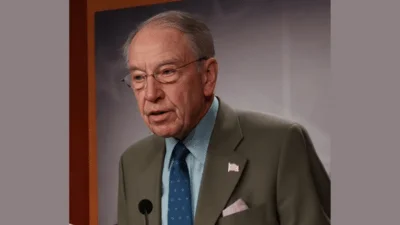The Congressional Record is a unique source of public documentation. It started in 1873, documenting nearly all the major and minor policies being discussed and debated.
“2000 CENSUS” mentioning the U.S. Dept. of Commerce was published in the House of Representatives section on pages H694-H695 on March 3, 1998.
The publication is reproduced in full below:
2000 CENSUS
The SPEAKER pro tempore. Under the Speaker's announced policy of January 21, 1997, the gentlewoman from New York (Mrs. Maloney) is recognized during morning hour debates for 5 minutes.
Mrs. MALONEY of New York. Mr. Speaker, last week one of my colleagues came to the House floor and said that the planning for the 2000 census was done in secret. I am here today to put the facts on the table so that the American people can decide for themselves. Designing the 2000 census has been one of the most public processes in the history of the census.
Dr. Barbara Bryant, the director of the Census Bureau for President George Bush, began the process in 1991 shortly after the conclusion of the 1990 census. She took over the Census Bureau less than 4 months before the 1990 census began, and she knew that it could be improved. The results from the 1990 census reinforced that decision.
In partnership with Congress, Dr. Bryant began the process that resulted in the census design we are debating today. To achieve a better census design, Congress turned to the National Academy of Sciences.
The gentleman from Kentucky (Mr. Rogers) testified before the House Subcommittee on the Census in 1991 and said there is a need for ``an independent review of the census that is fundamental in nature, a back-
to-basics, zero-based study that begins with no preconceived notions about what we collect or how we collect it. For that reason, I have pursued the idea of having the National Academy of Sciences conduct such a review. The Academy is credible, experienced, and more importantly, independent. Plus, I have been satisfied they can pull together a panel of fine minds, capable of blending fresh policy viewpoints with an understanding of statistical methods.''
In 1992 Congress passed H.R. 3280, ``a bill to provide for a study to be conducted by the National Academy of Sciences on how the government can improve the decennial census of population, and on related matters.'' That study laid out the blueprint for the 2000 census.
It has been alleged that there has been no congressional involvement in planning the census. But how can that be, when the design for the census is based on a study mandated by Congress? In addition, between 1991 and 1994 there were 15 House and Senate hearings on the 2000 census.
If there has been any neglect, it has been since 1995 when Congress abolished the Subcommittee on the Census. In 1995, 1996 and 1997 there were only 4 hearings on the 2000 census.
My colleagues have suggested that there has been no public involvement in designing the census. Again, I would like to have the facts speak for themselves. In 1992 the Secretary of Commerce established an Advisory Committee on the 2000 Census made up of nearly 50 organizations. I would like to put a list of those organizations into the Record.
The list referred to follows:
The National Governors Association, the American Association of State Highway and Transportation Officials, the American Statistical Association, the Association of State and Territorial Health Officials, the Business Roundtable, the Council of Chief State School Officers, the Federation for American Immigration Reform, the National Association of Counties, the National Association of Secretaries of State, the National Association of Towns and Townships, and the U.S. Chamber of Commerce.
Mr. Speaker, these organizations met over 20 times since 1992 and each meeting has been open to the public.
The activities of public involvement were not just here in Washington. The director of the Census Bureau and the Under Secretary for Economic Statistics at the Department of Commerce have gone to scores of cities and held town meetings to get public involvement. At each of these town meetings they have solicited public input on the plans that they have put before the public for conducting a fair and accurate census for 2000.
My colleagues have criticized the administration for developing a census designed by the experts. I wonder why they would want a census designed by amateurs.
The facts are that developing the design for the 2000 census has been one of the most public processes in the history of the census. The process has included major constituent groups, Congress and the public. The design for the census has been endorsed by experts and nonexperts alike.
It is very simple. In 1990 the census had an error rate of over 10 percent. Those who oppose a more accurate census want to go back to the way it was done in 1990, even if it costs more, because they believe that the errors in the census work to their advantage. The administration has put forward a plan to reduce the errors in the census and make it more fair and accurate.
The choice is simple. Do we move into the 21st century with a census that uses modern, scientific methods to count absolutely everyone? Or do we do it the old way and pay more to get a census that has millions of errors in it? I say we follow the plan of Dr. Bryant and the National Academy of Sciences.
Organizations That Support Sampling
American Jewish Committee, National Association of Counties, American Statistical Association, U.S. Conference of Mayors, Council of Professional Associations on Federal Statistics, Children's Defense Fund, Arab American Anti-Discrimination League, American Sociological Association, National League of Cities, and Cuban American National Council, Inc.
National Association of Business Economists, Japanese American Citizens League, Association of University Business and Economic Research, National Asian Pacific American Legal Consortium, Association of Public Data Users, Americans for Democratic Action, National Community Action Foundation, Asian Pacific American Labor Alliance, Consortium of Social Science Associations, and AFL-CIO.
Labor Council for Latin American Advancement, Leadership Conference on Civil Rights, League of United Latin American Citizens, Mexican American Legal Defense and Education Fund, NAACP, National Council of La Raza, National Urban League, Organization of Chinese Americans, Teachers of English to Speakers of Other Languages, California Rural League Assistance, and American Association of State Highway and Transportation Officials.
____________________








